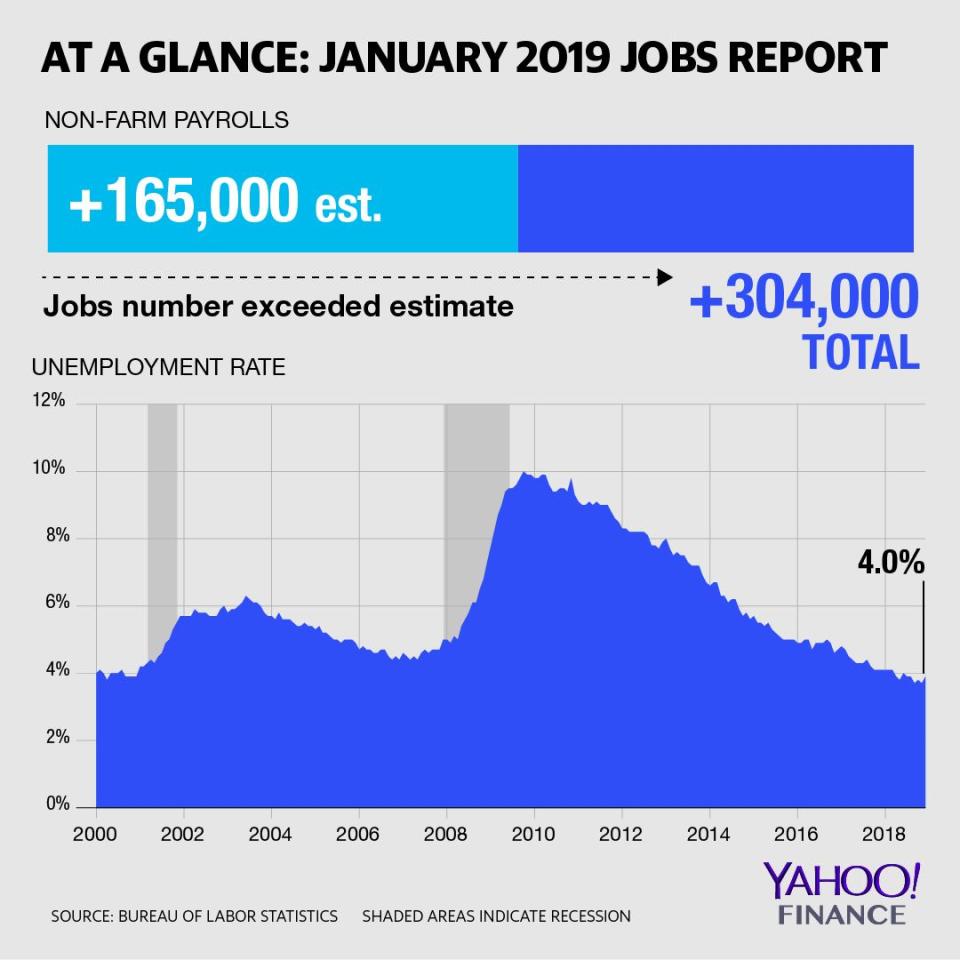U.S. economy added more jobs than expected in January, unemployment rate rose to 4%
The January jobs report shows the U.S. labor market is still chugging along.
The U.S. economy added 304,000 non-farm payrolls in the first month of 2019, ahead of consensus expectations of 165,000.
December’s number, however, was revised down to 222,000 from 312,000 previously.
Nevertheless, the net gains in jobs was stronger than expected. Following Friday’s jobs report, the new three-month average for job gains in the U.S. stands at about 241,000, up from 231,000 following December’s revised reading.
“There was a very, very positive vibe all around [in the White House],” Kevin Hassett, President Trump's chairman of the Council of Economic Advisers, said in an interview with Yahoo Finance. “I got, for the first time since I've been here, a knuckle bump from the President.”
The unemployment rate rose to 4.0%, largely due to the government shutdown, which had government workers identifying themselves as temporarily laid off. December’s unemployment rate was left unchanged at 3.9%. The rise in January’s unemployment rate was also due in part to an increase in the labor force participation rate, which climbed to 63.2% from 63.1% in December. January’s participation level marks the highest since 2013.
Average hourly earnings rose 0.1% over December and 3.2% over last year. This compares to consensus estimates of a 0.3% increase and 3.2% increase, respectively, for January average hourly earnings. In December, wage growth increased 0.4% month-over-month and 3.3% year-over-year, after revisions. Hourly earnings are closely watched as a key gauge of inflation, and January’s average month-over-month hourly wage gain represents the slowest climb since October 2017.
The strong economy continues to add jobs, while inflation continues to be very low. This gives the Fed significant flexibility to be patient with future interest rate hikes, as had been their stated approach based on their most recent policy decision earlier this week. Fed officials in their policy statement Wednesday noted that inflation pressures were “muted.”
The labor market has by-and-large been a bright spot for the U.S. economy even as concerns ratcheted up over slowing international economic growth. In its latest policy statement Wednesday, the Fed also characterized labor market conditions as “strong,” while downgrading its assessment of the broader domestic economic activity from “strong” to “solid.”
“On the heels of a strong January this is another win for the bulls, and could help keep the momentum going,” said Mike Loewengart, VP of investment strategy for E-Trade Financial Corporation. “Fundamentals are standing strong—they haven’t seen their shadow just yet.”
Strong unemployment data could also translate into solid retail sales results on Monday, Loewengart added. And larger purchases – such as home sales – could get a lift based on unemployment levels and the Fed’s indications that they may pause rate hikes.
“For now it looks like we are back in a sweet spot of strong economic fundamentals and a dovish Fed,” Loewengart said.

Many economists noted that January’s results could contain some “noise” due to impact from the 35-day partial government shutdown. For the Bureau of Labor Statistics’ establishment survey – which produces data on non-farm payrolls, earnings and hours worked – furloughed workers were counted as employed since their back pay was guaranteed.
For household survey data – including results for household employment, unemployment and labor force participation – furloughed workers who were not working for the BLS survey’s entire reference week were counted either as unemployed or temporarily laid off.
According to the BLS, the impact of the shutdown had some effect on January’s results. “Both the unemployment rate, at 4.0 percent, and the number of unemployed persons, at 6.5 million, edged up in January,” the BLS said in a statement. “The impact of the partial federal government shutdown contributed to the uptick in these measures. Among the unemployed, the number who reported being on temporary layoff increased by 175,000.”
However, the BLS added, “There were no discernible impacts of the partial federal government shutdown on the estimates of employment, hours and earnings from the establishment survey.”
The protracted partial government shutdown did add weight to Friday’s jobs report as it impacted the release timing of other critical economic data used to inform market participants and policymakers. A first reading of fourth-quarter gross domestic product, for instance, was due for release this week, but has been delayed since a host of data that factors into the index has not been available due to the shutdown. Recent data on personal income and spending, durable-goods orders, retail sales and housing starts have also not yet been released.
The timing of the January and December jobs reports were not impacted by the partial government shutdown since Congress had already approved a spending bill providing funding for the Department of Labor.
“During the time it takes to get the postponed economic indicators back on schedule and allow greater confidence gauging economic strength, the Fed will continue to lean heavily on the performance of the labor market,” Sam Bullard, managing director and senior economist for Wells Fargo Securities, wrote in a note ahead of Friday’s report.
—
Emily McCormick is a reporter for Yahoo Finance. Follow her on Twitter: @emily_mcck
Follow Yahoo Finance on Twitter, Facebook, Instagram, Flipboard, LinkedIn, and reddit.
Read more from Emily:
What Wall Street strategists forecast for the S&P 500 in 2019
Beer sales are lukewarm and pot could be part of the problem
Consumer sentiment plunges to its lowest level since Trump’s election
Netflix revenue disappoints, shares dip
What corporate America is saying about the government shutdown